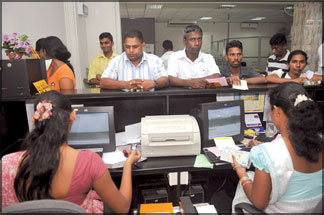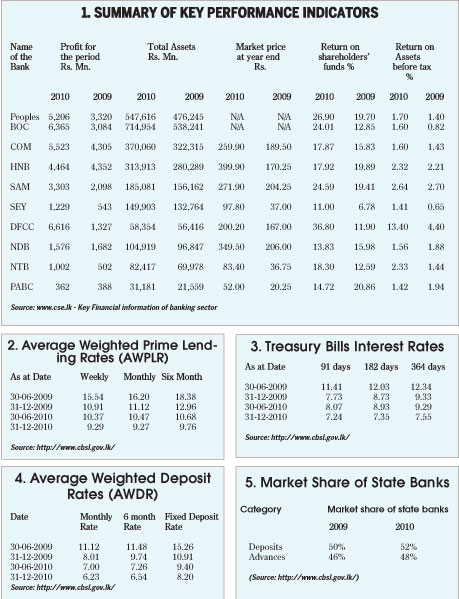Remarkable 2010 for Sri Lankan banking industry
Prasad Polwatte and Asanka Liyanage
As the effects of the financial crisis permeated into the Sri Lankan
economy, a noticeable indolence in the financial services sector was
evident throughout 2009.
|

The banking sector sustained its earnings via an increase in
investment income from government securities and equities |
This was further aggravated as repercussions of financial fall-outs
in the local industry were disclosed in the early part of 2009.
Domestic financial markers that were somewhat volatile at the
commencement of 2009 became more liquid and steady in the second half of
2009 and first half of 2010.
The Government’s post war economic development policies were lenient
on the monetary system and led to a declining inflationary pressures
situation in financial market. Resumption of capital inflows due to
reduced risk and improved investor sentiment has given a positive shock
to the banking industry.
This article compares and contrasts the performance of lincensed
Commercial Banks (LCBs) for 2009 and 2010. Both public and private LCBs
overall performance was comparatively higher in 2010 compared to the
2009.
All of the key performance indicators showed positive growths in
2010. Summary of Key Performance Indicators of 2010 and 2009 of Leading
LCBs are presented in Table 1.
Financial markets were more stable with improved liquidity and
declines in interest rates from the beginning of 2010. The exchange
rates remained more stable. Equity prices have surged upwards during the
year.

The banking sector sustained its earnings via an increase in
investment income from government securities and equities.
Almost all banks moved to long-term investments rather than
short-term investments. On the other hand they encourage short-term
borrowings as it was less costly than the long-term borrowings.
Overall drop apart from DFCC bank can be seen in total revenue
compared to 2009 in 2010. The main reason was the average drop in
interest income by 10 percent to 15 percent in almost all LCBs.
In the case of DFCC bank the results of 2010 included profit relating
to the sale of Bank’s shareholding in Commercial Bank of Ceylon PLC (CBC).
Sale of Commercial Bank shares have contributed Rs 5,282 million to
DFCC Bank’s profit.
The main reason for the drop in interest income of all LCBs was the
drop in lending rates from 15 percent 18 percent to 9.29 percent - 9.76
percent range in 2010
Even though an increasing trend was visible in the growth in Advance
portfolio of the banks (Approximately 20 percent - 30 percent) but the
interest income had dropped mainly due to the decrease in Average
Weighted Prime Lending Rates (AWPLR).
On the other hand LCBs concentrated on Government securities
specially Treasury bills, of which interest rates were decreased by
considerable percentage. Details are as follows: A material decrease in
interest expense was shown in 2010 to 2009. (Averagely 20% to 30% drop
in all banks).
The decrease in the Average Weighted Deposit Rates (AWDR) was the
main factor for this interest cost reduction. It is clearly evident in
the following table.
The deposit growth in 2010 (nearly 10 percent- 20 percent) has not
proportionately increased the interest cost in LCBs due to the drop in
AWDR.
On the other hand banks were unable to attract more deposits since
short-term deposit interest rates were less attractive and customers
tend to switch for more attractive investments such as Capital/Money
markets.
2010 can be considered as a remarkable year to increase LCBs profits.
Apart from NDB and PABC all other banks have recorded an increase in
their profit after tax in 2010 compared to 2009 (Nearly 50 percent to
100 percent).
The same increase can also be notified in Net Asset Per Share, EPS,
ROE and ROA. Further, two State banks were able to sustain their market
share on deposits and advances with slight increase.
This year is also a blooming year for all banks since the government
has given several encouragements in its budget proposal. They are:
* Reduction of Corporate Tax from 35 percent to 28 percent and
reduction of Nation Building Tax (NBT) will improve profitability of
most listed companies
* Reduction of Financial Services VAT (FS VAT) from 20 percent to 12
percent. However such institutions are expected to create an investment
fund that can be utilized to grant attractive credit facilities
including long-term loans at a lower rate of interest.
* Removal of debit tax will also have a positive impact on LCBs
deposit growth.
The ban king sector is continuously seeking opportunities in the
North and East for market exposure. On the other hand the CBSL is of the
view that further decrease in interest rates in the future is possible
and the banking sector should take into account the amount of customer
deposits that can be overlooked due to further decrease in the interest
rates. LCBS will face great challenges in 2011 to sustain it level of
performance of 2010. |



